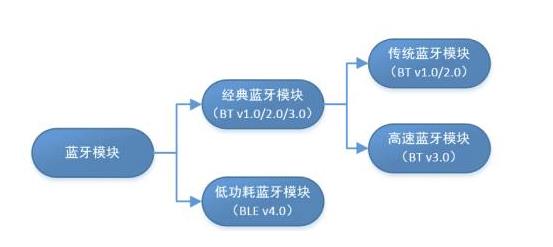传统蓝牙学习记录:蓝牙基础
Posted 福尔摩聪
tags:
篇首语:本文由小常识网(cha138.com)小编为大家整理,主要介绍了传统蓝牙学习记录:蓝牙基础相关的知识,希望对你有一定的参考价值。
一:传统蓝牙基础知识
传统蓝牙:所谓传统蓝牙,其实是蓝牙4.0以前的蓝牙技术的统称,在蓝牙4.0之后的的蓝牙称为BLE(Bluetooth Low Energy),关于Ble的知识可以放在以后再说。

二:蓝牙常用的几个API:
1.蓝牙适配器BluetoothAdapter
无论是使用传统蓝牙还是BLE都要调用这个API,可以把它看做蓝牙的管理器。这个api里面有好多方法都是我们在使用蓝牙时需要用到的:
bluetoothAdapter=BluetoothAdapter.getDefaultAdapter(); //静态方法,获取默认的蓝牙适配器对象;
bluetoothAdapter.enable(); //打开蓝牙
bluetoothAdapter.disable(); //关闭蓝牙
bluetoothAdapter.isEnabled(); //判断蓝牙功能是否打开
bluetoothAdapter.startDiscovery(); //开始搜索周围设备
bluetoothAdapter.isDiscovering(); //判断当前设备是否正在搜索周围设备
bluetoothAdapter.cancelDiscovery(); //停止搜索周围设备
bluetoothAdapter.getBondedDevices(); //获得已经配对的设备列表
bluetoothAdapter.getAddress(); //获得本设备的address
bluetoothAdapter.getName(); //获取本设备的蓝牙名字2.蓝牙设备BluetoothDevice
顾名思义,这个API是用来获取蓝牙设备的一些信息。要注意,这个device代表的是对方的设备,而不是本机的设备,这个一定不要混淆了。BluetoothDevice常用的一些方法如下:
bluetoothDevice.getName(); // 获取设备的蓝牙名字
bluetoothDevice.getAddress(); //获取设备的address
bluetoothDevice.getBondState(); //获取设备的绑定状态
bluetoothDevice.createBond(); //与该设备创建绑定
bluetoothDevice.createRfcommSocketToServiceRecord(UUID.randomUUID()); //创建一个BluetoothSocket;3.蓝牙套接字BluetoothSocket和蓝牙服务器套接字BluetoothServiceSocket
两个蓝牙设备创建连接并互相发送消息,必须有一个是客户端,另一个是服务端。当两台设备配对成功之后,客户端向服务端发送socket连接请求,服务端接收到socket连接请求之后,建立连接,双方开始收发数据。
BluetoothSocket常用的方法如下:
bluetoothSocket.close(); //关闭连接传输并释放资源
bluetoothSocket.connect(); //尝试连接到远程设备
bluetoothSocket.getConnectionType(); //获取底层连接的类型
bluetoothSocket.getInputStream(); //获取与这个套接字相关联的输入流
bluetoothSocket.getOutputStream(); //获得与这个套接字相关联的输出流
bluetoothSocket.getMaxReceivePacketSize(); //获取底层传输的最大支持接收数据包大小。
bluetoothSocket.getRemoteDevice(); //获取这个套接字连接的远程设备
bluetoothSocket.isConnected(); //判断是否与远程设备建立了活动连接BluetoothServiceSocket常用的方法如下:
bluetoothServerSocket.accept(); //一直阻塞直到连接建立。
bluetoothServerSocket.accept(int timeout); //一直组摄直到连接建立或者超过timeout
bluetoothServerSocket.close(); //关闭这个socket并且释放资源三:开启和使用蓝牙服务所需要的权限
<uses-permission android:name="android.permission.BLUETOOTH_ADMIN"/>
<uses-permission android:name="android.permission.BLUETOOTH"/>
<uses-permission android:name="android.permission.ACCESS_COARSE_LOCATION"/>在android6.0之后,必须加上第location权限,否则在搜索周围设备时返回的设备列表为空!!!!!!
四:蓝牙的开启与搜索
1.蓝牙的开启:
蓝牙的开启方式可以分为两种:隐式开启和弹出对话框开启。
//隐式开启
if(!bluetoothAdapter.isEnabled())
bluetoothAdapter.enable();
//弹出对话框开启
if(bluetoothAdapter!=null && !bluetoothAdapter.isEnabled())
Intent intent=new Intent(BluetoothAdapter.ACTION_REQUEST_ENABLE);
startActivity(intent);
2.搜索周围蓝牙设备并且显示出来:这里直接上代码:
activity_main.xml:(蓝牙设备列表通过recyclerview显示出来)
<?xml version="1.0" encoding="utf-8"?>
<LinearLayout xmlns:android="http://schemas.android.com/apk/res/android"
xmlns:tools="http://schemas.android.com/tools"
android:layout_width="match_parent"
android:layout_height="match_parent"
tools:context=".MainActivity"
android:orientation="vertical">
<Button
android:id="@+id/btn1"
android:layout_width="wrap_content"
android:layout_height="wrap_content"
android:text="搜索设备"
/>
<android.support.v7.widget.RecyclerView
android:id="@+id/device_list"
android:layout_width="match_parent"
android:layout_height="wrap_content">
</android.support.v7.widget.RecyclerView>
</LinearLayout>dev_item.xml:(列表中每一个item的布局)
<?xml version="1.0" encoding="utf-8"?>
<LinearLayout xmlns:android="http://schemas.android.com/apk/res/android"
android:layout_width="match_parent"
android:layout_height="wrap_content"
android:orientation="horizontal">
<TextView
android:id="@+id/name"
android:layout_width="wrap_content"
android:layout_height="wrap_content" />
<TextView
android:id="@+id/address"
android:layout_width="wrap_content"
android:layout_height="wrap_content" />
</LinearLayout>DeviceAdapter.java:
package com.example.liucongcong.bluetoothtest1;
import android.bluetooth.BluetoothDevice;
import android.content.Context;
import android.support.annotation.NonNull;
import android.support.v7.widget.RecyclerView;
import android.view.View;
import android.view.ViewGroup;
import android.widget.TextView;
import java.util.ArrayList;
import java.util.List;
public class DeviceAdapter extends RecyclerView.Adapter<DeviceAdapter.MyViewHolder>
private List<BluetoothDevice> bluetoothDevices=new ArrayList<>();
Context context;
public DeviceAdapter(Context context,List<BluetoothDevice> bluetoothDevices)
this.context=context;
this.bluetoothDevices=bluetoothDevices;
@NonNull
@Override
public MyViewHolder onCreateViewHolder(@NonNull ViewGroup viewGroup, int i)
View v= View.inflate(context,R.layout.dev_item,null);
return new MyViewHolder(v);
@Override
public int getItemCount()
return bluetoothDevices.size();
@Override
public void onBindViewHolder(@NonNull MyViewHolder holder, int position)
holder.name.setText(bluetoothDevices.get(position).getName());
holder.address.setText(bluetoothDevices.get(position).getAddress());
public void addDev(BluetoothDevice device)
if (bluetoothDevices.contains(device))
return;
bluetoothDevices.add(device);
notifyDataSetChanged();
class MyViewHolder extends RecyclerView.ViewHolder
TextView name;
TextView address;
public MyViewHolder(View v)
super(v);
name=v.findViewById(R.id.name);
address=v.findViewById(R.id.address);
MainActivity.java:
package com.example.liucongcong.bluetoothtest1;
import android.bluetooth.BluetoothAdapter;
import android.bluetooth.BluetoothDevice;
import android.content.BroadcastReceiver;
import android.content.Context;
import android.content.Intent;
import android.content.IntentFilter;
import android.support.v7.app.AppCompatActivity;
import android.os.Bundle;
import android.support.v7.widget.DividerItemDecoration;
import android.support.v7.widget.LinearLayoutManager;
import android.support.v7.widget.RecyclerView;
import android.view.View;
import android.widget.Button;
import android.widget.Toast;
import java.util.ArrayList;
import java.util.List;
public class MainActivity extends AppCompatActivity
BluetoothAdapter bluetoothAdapter;
private Button mSearch;
private RecyclerView recyclerView;
private List<BluetoothDevice> bluetoothDevices=new ArrayList<>();
DeviceAdapter mydaapter;
int i=0;
//接收其他蓝牙设备发送的广播
private BroadcastReceiver broadcastReceiver=new BroadcastReceiver()
@Override
public void onReceive(Context context, Intent intent)
String action=intent.getAction();
if(BluetoothDevice.ACTION_FOUND.equals(action))
BluetoothDevice device=intent.getParcelableExtra(BluetoothDevice.EXTRA_DEVICE);
//在列表里面加上该项
mydaapter.addDev(device);
;
@Override
protected void onCreate(Bundle savedInstanceState)
super.onCreate(savedInstanceState);
setContentView(R.layout.activity_main);
mSearch=(Button)findViewById(R.id.btn1);
recyclerView=findViewById(R.id.device_list);
IntentFilter intentFilter = new IntentFilter();
intentFilter.addAction(BluetoothDevice.ACTION_FOUND);
registerReceiver(broadcastReceiver, intentFilter);
//开启蓝牙begin
bluetoothAdapter=BluetoothAdapter.getDefaultAdapter();
//弹出对话框提示用户开启蓝牙
if(bluetoothAdapter==null)
Toast.makeText(MainActivity.this,"此设备不支持蓝牙",Toast.LENGTH_LONG);
finish();
if(bluetoothAdapter!=null && !bluetoothAdapter.isEnabled())
Intent intent=new Intent(BluetoothAdapter.ACTION_REQUEST_ENABLE);
startActivity(intent);
//开启蓝牙end
mydaapter=new DeviceAdapter(this,bluetoothDevices);
recyclerView.setLayoutManager(new LinearLayoutManager(this, LinearLayoutManager.VERTICAL, false));
recyclerView.setAdapter(mydaapter);
recyclerView.addItemDecoration(new DividerItemDecoration(this,DividerItemDecoration.VERTICAL));
mSearch.setOnClickListener(new View.OnClickListener()
@Override
public void onClick(View v)
if(bluetoothAdapter.isDiscovering())
bluetoothAdapter.cancelDiscovery();
bluetoothAdapter.startDiscovery();
);
总结: 到这里传统蓝牙的开启和搜索小伙伴们应该都已经熟悉了,在下一篇中将记录传统蓝牙的配对与连接。
还有,android6.0之后必须申请location权限,否则会搜索不到周围的蓝牙,切记~~~~
以上是关于传统蓝牙学习记录:蓝牙基础的主要内容,如果未能解决你的问题,请参考以下文章